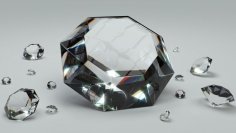
Diamond is the hardest mineral on the Mohs scale of hardness. There's nothing harder. Yet diamond is just carbon. Like coal or graphite. Unlike them, the carbon atoms in diamond have taken the cubic allotropic form.
Squeeze a piece of coal hard enough and you get a diamond.
Ever since people discovered that diamonds are carbon, like coal, attempts have been made regularly to compress a piece of coal hard enough to produce a diamond.
What's the difference between diamond substitutes and synthetic rubies, sapphires, and emeralds? Synthetic rubies, sapphires, spinels, and emeralds are created by humans using the same methods that nature once used to create real rubies and emeralds. Diamond substitutes, however, are crystals with a different composition than diamond crystals. They simply resemble real diamonds in their refraction and the play of light, but have a completely different chemical composition.
Is it possible to get a diamond from coal?
Ever since people learned to polish diamonds into sparkling brilliants, diamond counterfeiting has been on the rise. Initially, counterfeits were made from simple glass, then from lead glass. Soon, distinguishing rhinestones from diamonds became a difficult task.
Quite often it was possible to come up with very successful substitutes for jewelry diamonds.
Hollywood stars and some queens, owners of unique diamonds, often preferred to wear skillfully crafted rhinestones to social events – substitutes for their unique diamonds.
Simply to save money: such a rhinestone, almost indistinguishable from the original, cost a little more than the insurance from Lloyd's for such a super diamond against theft for one evening.
But there has never been a synthetic diamond completely identical to the original. Fakes were given away by a different play of light (dispersion) than a diamond, without exception they were significantly less durable, and many showed differently in X-rays than diamonds… It was always possible to spot a fake. However, sometimes only with sophisticated equipment.
But in 1956, General Electric announced the successful synthesis of diamonds. A few years passed, and the production of synthetic industrial diamonds became widespread. Thousands and millions of carats were produced using sophisticated equipment.
Synthetic diamonds have become an important part of technological development. Cutting tools reinforced with tiny diamond crystals have proven to be much more durable than similar tools made from the best alloys. Demand for industrial diamonds has grown.
Before World War II, up to 7 million carats of industrial diamonds were consumed annually in technology. Once synthetic diamond production was established, industrial diamond consumption began to grow rapidly.
By 1970, 70 million carats were used in technology, and by 1990, about 250 million carats. By 2010, industrial diamond production had grown to 5 billion carats. Currently, the world produces approximately 10 billion carats of synthetic industrial diamonds annually.
Moreover, since the beginning of the 21st century, China has led the production of synthetic diamonds, accounting for approximately 80% of the global total. Moreover, 131.1 million carats of gem-quality diamonds were mined in 2014. China is the leader among synthetic diamond producers.
Nowadays, very small diamond crystals, known as diamond dust, are mostly synthesized. They are used in the production of all kinds of grinding pastes, and synthetic diamonds are also included in numerous stone-cutting and metalworking tools. Diamond glass cutters, drills, drilling heads, saws, chisels, and dies perform many times longer and better than their predecessors made from special steel alloys. Moreover, the price of synthetic diamonds has already dropped to approximately $1 per carat.
Experts estimate that there are currently only about 1,000 diamond synthesis facilities operating worldwide. The earliest facilities utilized high-pressure, high-temperature (HPHT) synthesis technology, but at the end of the 20th century, carbon vapor deposition (CVD) technology was discovered for diamond production. These two methods are closely related.
The HPHT method produces a small crystal, which subsequently serves as a seed for the CVD method.
Using a combination of both methods, scientists have developed techniques for producing diamond plates, which have already found application in electronics. Increasing the size of these plates will enable their widespread use, including as watch crystals. Diamond plates are considered a potential future basis for electronics.
In addition to the production of industrial diamonds, which have long since secured their place in global technology, attempts to synthesize gem-quality diamonds continue. In fact, the fundamental possibility of this was demonstrated back in the 1970s, when several gem-quality diamonds were produced in the USSR as a test sample (the jeweler who polished them mistook them for small diamonds from Sierra Leone). However, their price was apparently so high that the experiment was abandoned. Gem-quality diamonds are still practically exclusively mined “from the earth”—those produced by nature many hundreds of millions of years ago.
But scientists aren't despairing. New diamond synthesis technologies have already emerged. To produce a 1-carat diamond using HPHT technology, a setup must operate continuously for approximately five days (which significantly increases the price of the resulting diamond). Currently, in China, combining HPHT and CVD technologies, they are producing cylindrical and cubic “diamond blanks.” These are diamonds, but compared to real diamond crystals, they have an irregular structure.
But technology never stands still. It's safe to say that, in time, man-made diamonds will be indistinguishable from the real thing, as people's love for diamonds is so strong.





